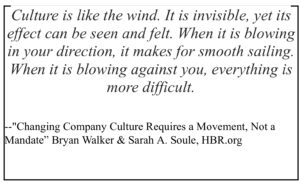An insider’s look at shifting the tide in a large organization.
By Molly Russin
Can you really change Culture? The simple answer is Yes. Unfortunately, there is no easy answer. That’s why there are hundreds of thousands of articles and books on this very topic. I could cite them all but then this wouldn’t be a blog, it would be a white paper. One fact everyone agrees on is this: about 37% of change initiatives succeed. No matter how much time, effort, blood, sweat or tears are poured into the remaining 63%, they fail. I worked for a large corporation that experienced multiple Cultural changes, refreshes and tweaks over two decades. Here are 3 critical questions you must be able to answer if you want to join the 37% club.
1. What exactly does “change the culture” mean? In my mind, culture means the ways that work gets done in an organization; some might refer to them as habits or ingrained ways of working. A positive example might be something like, We always put our customers first. A negative aspect of culture might be, We nod in agreement when a new initiative i s presented but afterwards we secretly tell each other what we really think (and it usually isn’t agreement). It’s important to decide if you think the entire culture needs an overhaul or just certain aspects of it. Be careful not to throw out the baby with the bathwater, as the saying goes! One more thing: if the cultural shift is actually just a new technology or process, maybe what you really need is Change Management. But that’s another topic for another day.

2. What is the desired change and why is it necessary? Who wants it? Who needs it? What will happen if the change doesn’t occur? These are questions that often get asked early in the process, not answered very well, and then tossed aside while the “real work” gets done. It’s critical that a cultural shift is explained with absolute clarity and extra crispy articulation. I believe the reason so many organizations bring in consultants to assist with Culture Change initiatives is because it’s easier for “outsiders” who aren’t wed to the old ways of doing things to explain what the changes are and why they’re needed.
If the folks on the receiving end seem confused, remember that it’s not their job to get it…it’s your job to help them understand. Keep trying until you see lots of nodding heads…not bobbing heads that say yes to everything because they aren’t listening, but nodding heads.
3. How will progress be measured and what happens if change isn’t happening? Once you’ve defined what Culture changes will be made and everyone is on board with the desired end state, it’s critical to decide how progress will be measured—even before a plan is put in place. What does good look like and how will you know when it’s happening and when it’s not? What steps will be taken if you start to feel push-back (and you will)? Where is it coming from and why?
Sometimes it’s necessary to take a step back and rethink a plan. For instance, one “Customers First” transformation I was a part of included a mandate that all employees get to know more about our customers by meeting with at least one customer at least once a year. The intention was right and our staff was willing but it turned out that this would be a huge burden on our customers! They simply didn’t have the time to spend with folks who weren’t on the account team. We quickly figured out a variety of ways to educate non-customer facing staff about our customers businesses that didn’t involved face to face meetings and we were able to proceed with the strategy. As your team makes progress, be sure to report out, often, so that everyone understands that the plan is working and change is happening with everyone’s help.
Is your team thinking about a Culture Change in 2021? KDH Consulting can help you to put in place a winning strategy. Contact us today for help!